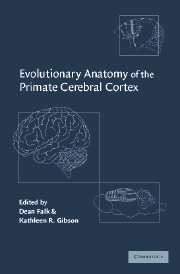Book contents
- Frontmatter
- Contents
- List of contributors
- Preface
- Prologue: Size matters and function counts
- Part I The evolution of brain size
- Introduction to Part I
- 1 Encephalization and its developmental structure: how many ways can a brain get big?
- 2 Neocortical expansion and elaboration during primate evolution: a view from neuroembryology
- 3 In defense of the Expensive Tissue Hypothesis
- 4 Bigger is better: primate brain size in relationship to cognition
- 5 The evolution of sex differences in primate brains
- 6 Brain evolution in hominids: are we at the end of the road?
- Part II Neurological substrates of species-specific adaptations
- Epilogue: The study of primate brain evolution: where do we go from here?
- Index
2 - Neocortical expansion and elaboration during primate evolution: a view from neuroembryology
Published online by Cambridge University Press: 07 October 2011
- Frontmatter
- Contents
- List of contributors
- Preface
- Prologue: Size matters and function counts
- Part I The evolution of brain size
- Introduction to Part I
- 1 Encephalization and its developmental structure: how many ways can a brain get big?
- 2 Neocortical expansion and elaboration during primate evolution: a view from neuroembryology
- 3 In defense of the Expensive Tissue Hypothesis
- 4 Bigger is better: primate brain size in relationship to cognition
- 5 The evolution of sex differences in primate brains
- 6 Brain evolution in hominids: are we at the end of the road?
- Part II Neurological substrates of species-specific adaptations
- Epilogue: The study of primate brain evolution: where do we go from here?
- Index
Summary
The neocortex is a hallmark of mammalian brain evolution and is the structure that provides the basis of human mental capacity and uniqueness. Since the time of its emergence in a mammalian ancestor perhaps 250 million years ago, the neocortex has expanded in both relative and absolute size independently in several mammalian lineages. This expansion is particularly apparent in anthropoid primates, in which the neocortex comprises up to 80% of the brain mass. The expansion occurs primarily in the surface area rather than in thickness. Further, the neocortex is parcellated into different cytoarchitectonic areas, which increased in number, size and complexity during the cortical evolution.
Traditionally, our insights into the evolution of the neocortex have come from physical anthropology and comparative anatomy (e.g. Ariëns Kappers et al., 1936; Armstrong & Falk, 1982; Butler, 1994; Herrick, 1948; Jerison, 1991; Kaas, 1988; Nauta & Karten, 1970; Northcutt & Kaas, 1995; Preuss, 1993). In contrast, genetic, molecular and cellular mechanisms by which the cerebral cortex might have evolved are only beginning to be scientifically explored (e.g. Simeone, 1998; Smith Fernandez et al., 1998). The present review is an attempt to interpret some of the recent advances in neuroembryology within the context of neocortical evolution. That the embryonic development of living species can provide clues about possible mechanisms underlying evolution is a well-established approach in evolutionary biology that has been used extensively (e.g. Gerhart & Kirschner, 1997; Gould, 1977; Haeckel, 1879; Richardson et al., 1997; Striedter, 1997, 1998).
- Type
- Chapter
- Information
- Evolutionary Anatomy of the Primate Cerebral Cortex , pp. 30 - 56Publisher: Cambridge University PressPrint publication year: 2001
- 35
- Cited by

